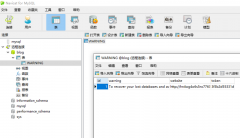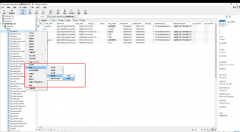教你用springboot连接mysql并实现增删改查
时间:2023-12-07下面我来详细讲解“教你用springboot连接mysql并实现增删改查”的完整攻略。
一、概述
本攻略将介绍如何用Spring Boot连接Mysql数据库,并实现常见的增删改查操作。首先,你需要搭建Spring Boot环境,并对Mysql数据库进行简单的配置。随后,通过使用Spring Boot的开发架构进行编写代码,最终实现对Mysql数据库的增删改查操作。
二、搭建Spring Boot环境
首先,你需要在你的开发环境中安装Java和Mysql,并且配置好环境变量。接下来,按照以下步骤进行Spring Boot工程的创建和环境搭建:
步骤一、创建Spring Boot工程
选择你最熟悉的IDE,在其中创建一个Spring Boot项目。项目名为springboot-mysql,建议使用Maven环境。
步骤二、导入所需的依赖包
在项目中打开pom.xml文件,将以下依赖添加到
<dependencies>
<dependency>
<groupId>org.springframework.boot</groupId>
<artifactId>spring-boot-starter-data-jpa</artifactId>
</dependency>
<dependency>
<groupId>mysql</groupId>
<artifactId>mysql-connector-java</artifactId>
</dependency>
</dependencies>
步骤三、在application.properties文件中配置Mysql连接信息
在项目的src/main/resources目录下,创建一个新的application.properties文件,添加以下代码:
spring.datasource.url=jdbc:mysql://localhost:3306/test
spring.datasource.username=root
spring.datasource.password=root
spring.datasource.driver-class-name=com.mysql.cj.jdbc.Driver
其中,test为Mysql的数据库名,root为数据库用户,root为该用户的密码。
至此,你已经完成了Spring Boot的环境搭建。
三、实现增删改查操作
步骤一、创建实体类和DAO层
在编写实体类和DAO层之前,需要先安装Lombok插件,以方便编写代码。
- 创建实体类
在src/main/java/com/example/demo/entity目录下,创建一个新的实体类,命名为User:
package com.example.demo.entity;
import lombok.Getter;
import lombok.Setter;
import lombok.experimental.Accessors;
import javax.persistence.*;
@Entity
@Getter
@Setter
@Accessors(chain = true)
@Table(name = "user")
public class User {
@Id
@GeneratedValue(strategy = GenerationType.IDENTITY)
private Long id;
@Column(name = "name")
private String name;
@Column(name = "age")
private Integer age;
}
在这个实体类中,使用注解进行表的映射,其中@Getter和@Setter注解来自于Lombok插件,让我们省去了大量的getter和setter代码。
- 创建DAO层
在src/main/java/com/example/demo/dao目录下,创建一个新的DAO层接口,命名为UserDao:
package com.example.demo.dao;
import com.example.demo.entity.User;
import org.springframework.data.jpa.repository.JpaRepository;
public interface UserDao extends JpaRepository<User, Long> {
}
在这个接口中,使用继承自JpaRepository的方法可以让我们轻松实现对Mysql的增删改查操作。
步骤二、创建Service层和Controller层
- 创建Service层
在src/main/java/com/example/demo/service目录下,创建一个新的Service层接口,命名为UserService:
package com.example.demo.service;
import com.example.demo.entity.User;
public interface UserService {
User save(User user);
void delete(Long id);
User update(User user);
User findById(Long id);
}
在该接口中,定义了对Mysql的增删改查方法。
- 创建Controller层
在src/main/java/com/example/demo/controller目录下,创建一个新的Controller层接口,命名为UserController:
package com.example.demo.controller;
import com.example.demo.entity.User;
import com.example.demo.service.UserService;
import org.springframework.beans.factory.annotation.Autowired;
import org.springframework.web.bind.annotation.*;
@RestController
@RequestMapping("/user")
public class UserController {
@Autowired
private UserService userService;
@PostMapping("")
public User save(User user) {
return userService.save(user);
}
@DeleteMapping("/{id}")
public void delete(@PathVariable("id") Long id) {
userService.delete(id);
}
@PutMapping("")
public User update(User user) {
return userService.update(user);
}
@GetMapping("/{id}")
public User findById(@PathVariable("id") Long id) {
return userService.findById(id);
}
}
在该Controller层中,使用注解标注来自于UserService的方法,实现对Mysql的增删改查操作。
步骤三、运行应用程序并进行测试
在你的开发环境中运行这个Spring Boot应用程序,并通过postman或者浏览器等工具进行测试。下面是两条示例说明:
- 查找用户(GET方法)
请求地址:localhost:8080/user/1
请求方式:GET
返回结果:
{
"id": 1,
"name": "lzj",
"age": 22
}
- 删除用户(DELETE方法)
请求地址:localhost:8080/user/1
请求方式:DELETE
返回结果:空
至此,你已经成功实现了Spring Boot与Mysql的连接并实现了增删改查操作。
 记录一次mysql数据库被黑删库遭比特币勒索的教训起因是想用服务器上的一个数据库访问其他数据库的权限,就直接按照网上教程改了mysql库里的user表的权限,可能是哪里权限修改问题,也没太在意,到了第二天发现网站登录不
记录一次mysql数据库被黑删库遭比特币勒索的教训起因是想用服务器上的一个数据库访问其他数据库的权限,就直接按照网上教程改了mysql库里的user表的权限,可能是哪里权限修改问题,也没太在意,到了第二天发现网站登录不 MySQL提示某表is marked as crashed and last (automatic)repair fai错误分析: 此错误为表损坏,修复即可。一般原因为服务器突然断电,而有程序还在往表里写数据。或者表的数据很大。避免浪费时间去修表。注意服务器操作时停掉数据库。另外
MySQL提示某表is marked as crashed and last (automatic)repair fai错误分析: 此错误为表损坏,修复即可。一般原因为服务器突然断电,而有程序还在往表里写数据。或者表的数据很大。避免浪费时间去修表。注意服务器操作时停掉数据库。另外